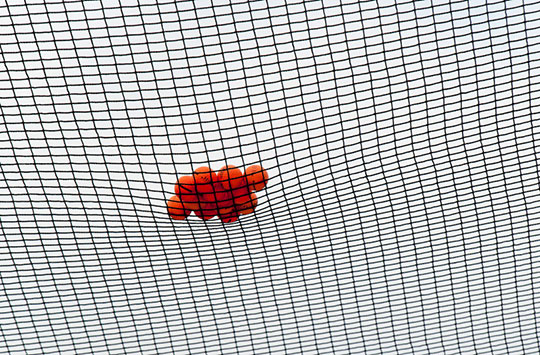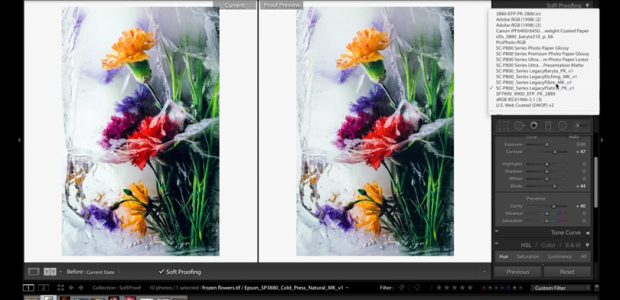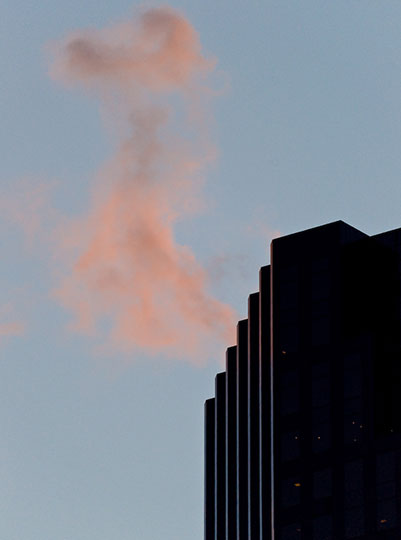
Warm Smoke. Toronto, December, 2008
Sony A900 with Sony 500mm Reflex lens at ISO 500
1/500 sec @ f/8
As this is published in the third week of December I have been working with the A900 for a bit more than a month. I have gained enough confidence (and admiration) for the camera at this point that I plan on taking it to Antarctica in January as my main system for the trip. My kit will consist of two A900 bodies, one with the vertical grip, and six lenses, the24-70mm Zeiss Vario Sonnar, 50mm f/1.4 Sony, 70-200mm f/2.8 Sony G, 135mm f/1.8 Zeiss Sonnar, 70-300mm f/5.6 Sony G,and500mm f/8 Reflex Sony.
Update:As this is being finalized for publication I have also added the Sigma 12-24mm and 50-500mm. I had hoped to have the new 16-35mm f/2.8 Zeiss and 70-400mm f/4-f/5.6 Sony lenses, but these will not become available till after my Antarctic shoot, so the Sigma’s were purchased as fill-ins. I’ll have a full report on these in late January when I get back. My initial impression of both lenses is very positive.
During the past month of shooting and testing and comparing I have made some observations, and a few discoveries. None of these are terribly profound, and may be already well known to Sony aficionados. But for someone considering the camera and system, or just becoming familiar with one, these comments may prove of some value.
____________________________________________________________________________________
Noise Compared to the Canon 5D MKII
The A900 has developed something of a reputation as a high noise camera – for the most part undeservedly so. As will be seen in my upcoming comparison with the class-leading Canon 5D MKII it does not have the high ISO capability that the Canon does. It’s that simple. But, at lower ISO’s, (under ISO 800) the A900 gives no ground to anyone.
On screen at 100% the A900 and the 5DMKII are essentially indistinguishable in terms of noise at ISO 100, 200, and 400. At ISO 800 the Canon has aslightedge, but nothing that a bit of luminance smoothing doesn’t instantly clear up. At higher ISO’s the Canon is the clear winner though. High ISO is not the Sony’s forte. The Sony is decent at ISO 1600, poor at ISO 3200 and pretty much unusable at ISO 6400. The Canon 5D MKII stays usable right up to ISO 6400, and 12,500 isn’t too shabby. 25,600 is for emergencies only, though still usable.
Just for interest we loaded a series of Sony and Canon files into Noise Ninja and noise profiled them. Remarkably, the Sony actually turned in lower noise numbers than the Canon up to and including ISO 400, though as mentioned both cameras are so clean at these speeds as to be indistinguishable visually in terms of noise. The Sony’s higher pixel density may be playing a role at high ISO’s, but at 400 and lower there’s no penalty to be paid. In fact, at 400 and under the A900 may have the highest combination of resolution and low noise of any DSLR currently available. (The Nikon D3x is not yet available to me for testing as this is being written).
Please note though that high ISO noise reduction in the A900 was turnedoff. Yes – it does affect raws as well as JPGs, and that effect is totally undesirable in raws. One is much better off doing any required noise reduction on high ISO A900 files in the raw processor or a post processing program such as Noise Ninja than using the camera’s built-in capability.
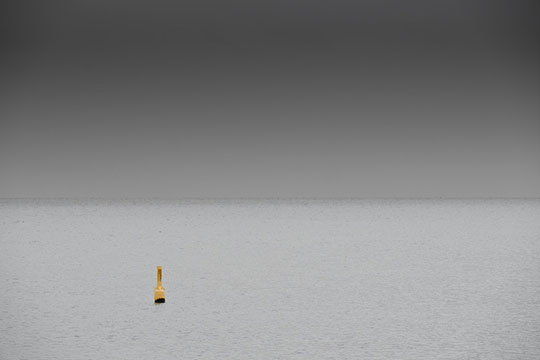
Yellow Buoy. Lake Ontario, December, 2008
Sony A900 with Sony 70-200mm f/2.8 G lens @ ISO 400
____________________________________________________________________________________
Raw Processing
Let’s be frank. Sony’s raw software (Image Data Converter) simply isn’t up to the competition. In fact it sucks, both in terms of user interface and image output quality. It’s hard to imagine that Sony isn’t embarrassed over releasing such a poor raw converter. (See sample high ISO conversion below).
There are currently quite a few other choices, includingLightroom 2,Adobe Camera Raw,Aperture(Mac only),Capture One 4 Pro,Iridient Raw Developer(Mac only), andRaw Photo Processor(Mac only).
I’ve been reading quite a few complaints online by A900 users that Lightroom and ACR do not do the best possible job on A900 raw files, particularly at high ISO. Since I’m a big fan of Lightroom and use it as my main everyday raw processor as well as teach it and produce training videos on it, I was curious to see for myself what the truth of the matter might be.
Well – I’ve almost gone blind pixel peeping and running the same files though all available raw processors (at least those that run on the Mac). Yes, Lightroom and ACR do seem to produce noisier high ISO conversions.
I do sometimes see what appear to be processing artifacts in the Lightroom and ACR files which are not seen in files from other converters, but then I see things in the others that also are a bit problematic. It’s very hard to make definitive judgments, because no sooner does it seem clear with a given file that one program does a better job than another, than a different file can turn in contrary results. It’s complicated.
Capture One 4 seems to do a very clean job with few processing artifacts. My workflow when using C1 is to simply load the files into that program and then do an export to DNG, loading that file into Lightroom through a Watched Folder. This provides the lower noise processing of C1 with most of the workflow advantages of Lightroom. Aperture is also highly regarded for A900 raws, and in fact appears to produce the lowest noise with the least sharpness degradation of any raw processor tested yet. But, since it can’t export a DNG one must continue the entire raw process in that program. No bad thing if you’re a Mac user and like and use Aperture, but no solution at all for those that use Windows or who prefer to stay in a parametric editor.
Raw Photo Processor does a sterling job on A900 files, and the program is donationware, but I find the workflow is so tedious that while it might appeal to the hobbyist, anyone working with more than a handful of files will find it frustrating. The workflow from Iridient Raw Developer is much better, though still not in the league of Lightroom or Aperture. Raw conversion from this program is very good, with a softer luminance noise pattern than RPP but more obvious chroma noise.
Two of the other leading raw processors,BibbleandDxO Optics Prohave not yet added A900 support, but I expect that they will before the end of January and may be well worth considering at that time.
ISO 6400 Processing Comparison




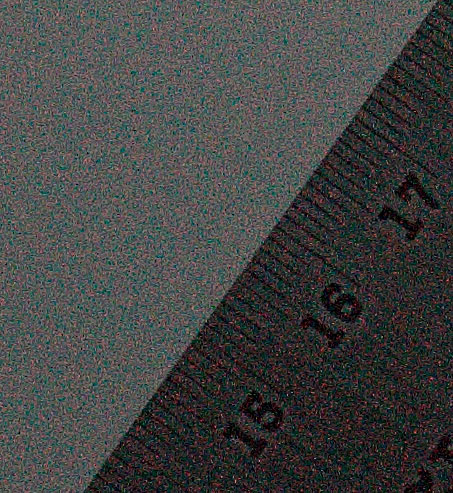
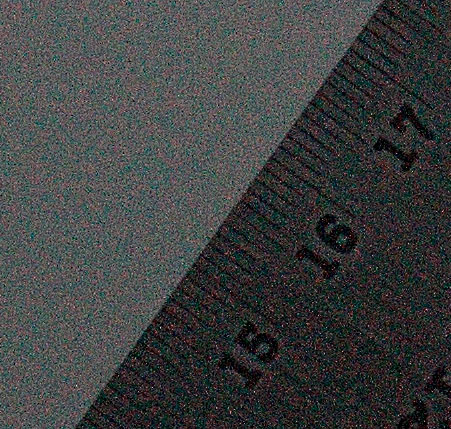
Raw Photo Processor
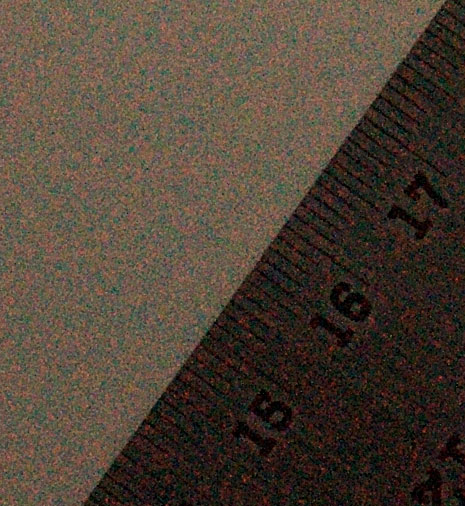
100% crops shot at ISO 6400 – a worst case example.
All conversions done at default settings.
(*) On Dec 19, as this article was being prepared for publication,Raw Photo Processorreleased version 3.8.3 with the following information…
New interpolation method – VCDMF based on "Variance of Color Differences" algorithm. It has better resolution, more naturally looking noise rendering, less artifacts and it’s a lot faster than AHDMF. This is the recommended method now.
The old and the new versions are shown together above. As mentioned in the body of this article, RPP may be the best raw processor extant for the A900 but its restricted workflow makes it suitable only for occasional use.
As for V3.8.3, it appears to be sharper than the previous version, and indeed produces the crispest conversions. The noise pattern is also the tightest of all converters at high ISOs, but in some ways it actually makes the noise more objectionable.
When you review the samples above what you’ll see is that Lightroom and ACR are no slouches when it comes to A900 conversions. Resolution appears equal to the best of the others, and while chroma noise is strong luminance noise is not as fine grained as some of the others, and therefore less objectionable to the eye. In fact, Lightroom and ACR files clean up better in Noise Ninja than do files from some of the others, simply because the noise isn’t as sharply defined.
At lower ISO there isn’t that much to choose between these programs. Workflow issues become more important than minor raw processing differences. In the end my use of Lightroom continues because of its superior workflow, and at lower ISO’s it also is capable of extracting lovely image quality from good files.
Finally, when looking at the above remember that these are 100% crops at ISO 6400. All of these converters, (except for Sony’s Image Data Converter) along with some decent noise reduction in a program such as Noise Ninja, will produce publication quality images at normal sizes from high ISO files. Sorry, but this is pixel peeping at its worst. The above examples are not intended to show the abilities of the A900, but rather to simply show the abilities of various raw converters with a worst case noise situation.
____________________________________________________________________________________
ISO 100
The A900 is a curious beast. It has excellent dynamic range. But, after some use it becomes clear that this is biased more toward the high end of the scale than the low, and so one has extended range in the three quarter tones and highlights, and a somewhat smaller range in the quarter tones and shadows. For most shooters, just the opposite of what you want.
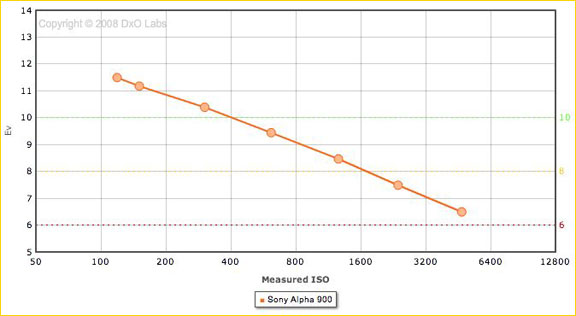
This graph from DxOMark shows that ISO 100 on the camera (actually ISO 119)
has 11.5 stops of dynamic range, while ISO 200 (actually ISO 151)
has 11.18 stops of dynamic range.
Not a lot of difference but definitely worthwhile.
More importantly, its the distribution of headroom from the highlights into the shadows
that makes the use of ISO 100 worthwhile in many instances.
The camera’s base ISO is 200, with ISO 100 being anextendedspeed. On most cameras the use of lower than native ISO is usually not a worthwhile exercise since it simply crushes dynamic range and contrast. But that’s not the case with the A900. What the use of ISO 100 appears to do is reduce headroom at the top end of the exposure scale, but opens it up about a half stop in the shadows. It also lowers the noise (which is already very low at 200) from a Noise Ninja reading of 11 down to 9. According to DxOMark the noise reduction is almost 1db, from a SNR of 35.2 at ISO 200 to 36.3 at ISO 100, corroborating what is seen in Noise Ninja.
Based on an extensive series of tests, I am now shooting with the A900 at ISO 100 when I can, which means when working on a tripod and when shadows are more important than highlights.
BUT: But, be aware that by reducing the ISO below the camera’s native 200 you are sacrificing one of the A900’s great image quality assets, and that’s its very broad highlight "shoulder". To my eye this gives the camera a very distinctive advantage in that highlights seem more film-like, with less of a tendency to clip, and to show more nuanced tonal and colour separation in lighter tones. For many current and prospective users, especially those with a sophisticated appreciation for the nuances of image quality, this highlight latitude may provide the camera’s biggest appeal, so only switch to ISO 100 in situations where slightly lower noise and more shadow range are what’s desired.
____________________________________________________________________________________
Intelligent Preview
The A900 doesn’t have Live View capability, something that I must say I miss. Apparently this is because Sony’s approach of using a second AF sensor in the prism housing wasn’t possible on the A900 due to the camera’s already huge prism.
Though it’s no substitute the camera does have a unique capability calledIntelligent Preview, which produces a temporary version on-screen and allows for setting various shooting parameters while showing on the preview and accompanying histogram what any changes made will do to the image.
I find this very handy for making quick adjustments to exposure compensation so as to achieve optimum exposure (Expose to the Right), since the dynamic histogram quickly indicates what will happen when the shot is actually taken.
If you have been ignoring Intelligent Preview, I suggest that you spend some time with it. It’s very worthwhile to become familiar with and a unique feature of this camera.
Gravity Well – Toronto, December, 2008
Sony A900 with Sigma 50-500mm lens @ ISO 320
____________________________________________________________________________________
The Grip
Coming from some years of using "pro"level cameras such as the Canon 1Ds MKII and Nikon D3 it was a pleasure going back to using a "normal" sized camera. Large bodies with integrated vertical grips are really useful and productive in many shooting situations, but I’ve been finding the extra bulk a drag a lot of the time.
What I appreciate about the A900 is that it provides the resolution and image quality that it does without forcing one to have a very large camera body. On the other hand, when using large lenses, and especially when shooting verticals with them, a vertical release is more than handy.
The A900’s grip solves the issue by being available when needed, and not when not. Of course this is far from the first camera to have an accessory grip, but what makes the VGC90AM vertical grip unique is the positioning of its release. The button is located about a quarter the way down the grip, rather than at the top, the way that it is on so many cameras. This makes it incredibly comfortable to use, making the camera feel much more balanced.
The duplication of almost every important control on the grip is also welcome, as is the automatic switching between the two batteries that it can hold. The fact that the camera’s battery cover does not need to be removed and stored, but rather simply slides into a slot in the grip, makes its attachment and removal than much more hassle free.
The grip comes with an anchor point for attaching a hand strap, but to my knowledge none is made by Sony. Fortunately Canon’s strap for the 1 Series works just fine. If you use the grip I highly recommend using a hand strap as well. It makes handling much more secure.
Really Right Stuffhas announced an L bracket for the A900 and are now accepting pre-orders.
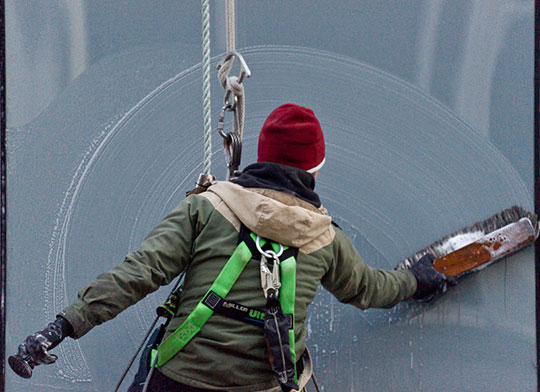
Window Washer – Toronto, December, 2008
Sony A900 with 500mm f/8 Reflex at ISO 3200
___________________________________________________________________________________
Lenses
One criticism that has been leveled at the Sony Alpha system is that its lens line isn’t as extensive as that of Canon and Nikon. True. But, as I wrote in my originalA900 review, one really has to ask oneself what’s missing (other than super teles and tilt / shift).
I don’t yet have a lot to add about the Sony and Zeiss lenses that I’m using beyond what I wrote originally, other than that I find them to be fully the equal if not in some cases superior to anything I’ve used from Canon or Nikon. After Antarctica and many thousands of additional frames I’ll likely have more to say. BTW – the50mm f/1.4Sony was recently reviewed on DPReview.
___________________________________________________________________________________
Shake That Booty
The A900 has dust removal sensor shake which works well, as it does on most contemporary cameras. I’ve found that sensor dust has been a negligible problem thus far, even though it’s winter and a time of year when sensor dust tends to be a greater problem due to the dryness indoors from central heating.
What is less common is that the camera features in-body image stabilization through sensor vibration, the first time that this has been accomplished on a full-frame camera. I have found this to be very much to my liking, especially with medium to wide angle lenses which heretofore have not been able to experience the benefits of stabilization. While less needed than with long lenses, it simply provides the ability to hand hold at lower speeds and in lower light situations, and therefore is most welcome.
The ability to have stabilization with all lenses, even those from third party lens makers, is also appreciated. The newly acquired Sigma 50-500mm is looking to be quite an excellent lens, and frankly, if I wasn’t using it on a camera body with stabilization I likely wouldn’t have considered purchasing it. I have the Canon 400mm f/5.6, which is an exceptional lens, but one which I rarely use because it lacks IS. With this in mind a lens such as the 50-500mm would not have appealed, but even after just a few days of use, as this article is being finalized, I am finding myself hand holding the lens at 400-500mm at speeds as low as 1/125 sec, and getting very fine results.
The bottom line on this long-winded discussion is that I am finding the Sony’s in-body stabilization to be very much to my liking, and something that makes me hesitate every time I go to pick up another camera which doesn’t have it.
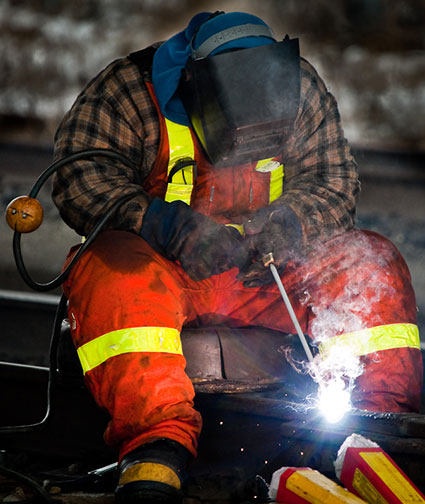
Track Welding. Toronto, December, 2009
Sony A900 with Sigma 50-500mm lens @ ISO 800
___________________________________________________________________________________
Sony A900 vs. Nikon D3x
Just prior to the appearance of this articleDavid Kilpatrick, a well regarded UK photographer and web author, published anAlpha A900 vs. Nikon D3x raw file noise comparison testonPhotoclub Alpha, a Sony Alpha enthusiast web site.
This is the first rigorously and professionally done comparison of files from these two 25MP cameras that I have seen, and I was very curious to note the results since Nikon has not seen fit to provide me with a D3x for testing yet. The A900 has, as noted above, received a bum rap because of its poor high ISO JPG performance. But, in raw comparisons with the new Canon 5DMKII I found it to be comparable and even slightly better at ISOs up to 400, a match at 800, and only then to fall behind the Canon.
Looking at the results of David’s D3x comparisons with the A900 I see a definite advantage to the Nikon at ISO 1600 and above, but nothing to convince me of the Nikon’s noise superiority at slower speeds.
The potential high ISO superiority (and at the price differential it would have had to be significant) of the Nikon D3x was one of the big question marks hanging over the Sony A900. If further such comparisons corroborate the evidence of David’s test files one sees that while Nikon has a visible high ISO advantage, at ISO 800 and below there is not much to choose between the two.
Bottom line – the D3x and A900 (and Canon 5DII, for that matter) differ little in their noise performance up to and including ISO 800. The Nikon and Canon pull ahead at ISO 1600 and above, and offer a one to one and half stop noise advantage over the A900 from there on up. On the other hand the A900 seems to offer at least a half stop greater dynamic range, especially in the highlights.
Once I and others can put all three cameras together in the same place at the same time we can have a shoot-out, but in the meantime, based on my own tests and that of reliable observers, I’m comfortable stating that at ISO 800 and lower it’s a quibble as to which of these three cameras has better low ISO noise performance. With the A900 starting to lag at ISO 1600 and above, as to whether the D3x or 5DMKII then becomes the low noise champ at higher ISOs, the jury still appears to be out.
For prospective purchasers I think that the questions that need to be asked are–What are my real shooting needs. What’s my budget? What is my current commitment to lenses?These are much more important questions on a practical basis than simply crowning one brand or another this month’s low noise king.
___________________________________________________________________________________
The Bottom Line – For Now
If it seems as if I’ve been waxing rhapsodic over the Sony A900, it’s because in fact I am. This is turning out to be an extremely enjoyable camera to use. Build quality is first rate, and the lack of top-rank weather sealing hasn’t prevented me from shooting in some recent snow storms with no ill effects. Image quality is as good as I’ve ever seen from any DSLR, and at 25 Megapixels provides the opportunity for very large prints as well as significant cropping potential when needed. With its high resolution the camera is very demanding of lenses, but so far I am very pleased with the lens selections that I’ve made. Dynamic range is in medium format back territory.
In-body stabilization is a real bonus. The viewfinder is the biggest and brightest that I’ve ever seen, and that includes the 1Ds MKIII and D3 family. The user interface provides a refreshing simplicity compared to the complexity of current Canon and Nikon offerings, though the Canon 5D MKII has a new interface that is a big improvement over what’s come before from that company. Amusingly it is much like that of the Sony in some regards.
Battery life is on the low side (sub 400 frames) when shooting raws (I’m told that it does much better when shooting JPGs, something which I rarely do). Otherwise, given the A900’s very attractive price point there simply isn’t a lot to be dissatisfied with. In body image stabilization is a major plus, as is the availability of some excellent Zeiss lenses.
Sure, Live View would have been nice, and video would have been a bonus, but for someone looking for a combination of performance and value I find the A900 very hard to top.
December, 2008
_____________________________________________________
Associated Articles
_____________________________________________________
You May Also Enjoy...
Soft Proofing In Lightroom – Tutorial With Jeff Schewe & Kevin Raber
Photography is about the print. You have heard it before and you’ll continue hearing this—at least from all of us at Luminous-Landscape. For some,
